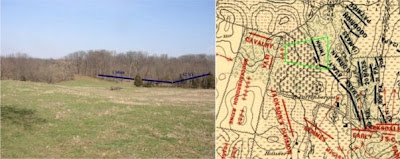 |
| From Rich Mountain |
Rich Mountain Battlefield lies a few miles from the town of Beverly, West Virginia along the old Staunton-Parkersburg Turnpike. “It’s a turnpike,” I told my wife. “How bad can it be?” The old road is now used mainly by recreational vehicles. Surfaced in gravel, it snakes its way up the mountain to the site of the battle between Federal forces under William S. Rosecrans and a small Confederate detachment under Captain Julius De Lagnel. This is not one for the faint-hearted, but the site is accessible by car and is well worth the time to visit.
Rich Mountain, a minor skirmish by late war standards, loomed large in the early careers of Rosecrans and George McClellan. Of more significance, McClellan’s indecision in the face of uncertainty here foreshadowed his efforts in later campaigns. McClellan sent Rosecrans with 2000 men, guided by a local farmer’s son, to flank the rebel position at Camp Garnett at the western foot of Rich Mountain. The march was expected to take three hours. Ten hours later, Rosecrans finally reached his flanking position at the Hart House.
Lieutenant Colonel John Pegram, commanding the 1300 troops at Camp Garnett, dispatched five infantry companies (perhaps 350 men) and a six pounder under the command of Captain De Lagnel to defend an overgrown track near the Hart House at the crest of the mountain. Ironically, though De Lagnel was in the right place to intercept Rosecrans, he faced his line in the wrong direction, expecting an attack from the North. Skirmishers from both sides clashed at Rosecrans closed in on the Hart House. Though the rebels anticipated an attack from the opposite direction, the Federals labored under the false assumption that all of the Confederate defenders were at Camp Garnett..
Despite their initial confusion, De Lagnel’s troops managed to repulse the first two Federal attacks. The Confederates let out a cheer and assumed they had won the day. Rosecrans, undaunted, launched another assault and carried the position.
Meanwhile, McClellan, fretting in the absence of any communications from Rosecrans, called off his supporting attack until the following day. Pegram’s grasp of the situation was no better. Hearing the cheers of De Lagnel’s men, he assumed his forces had achieved victory, and was dismayed to learn of their defeat. Even worse, his main escape route along the turnpike was now occupied by a superior force. Determined to avoid capture, Pegram set out in an attempt to escape the trap. Two days later, exhausted, hungry, and possibly lost, he decided to surrender his command.
The battlefield today consists of a small tract at the top of Rich Mountain near the site of the Hart House. The house no longer stands and trees have encroached upon much of what open pasture there was at the time, so interpretation of the site takes a bit of imagination.
Several plaques detail the action and guide visitors to the stable yard, a key to the rebel defense. Large flat rocks cover the ground here, and several contain inscriptions left by veterans of the action. Standing at the foot of the wooded slope from which Rosecrans launched his attack, visitors can easily imagine the consternation in the rebel ranks as they reoriented their defense to repel an assault from the opposite direction.
Though I lacked the time to explore Camp Garnett further west along the turnpike, the site boasts well preserved earthworks and is certainly worth a visit. Rich Mountain Battlefield would not exist today but for the efforts of the (http://www.richmountain.org). See their web site for information on the campaign and battle, as well as a schedule of events.

